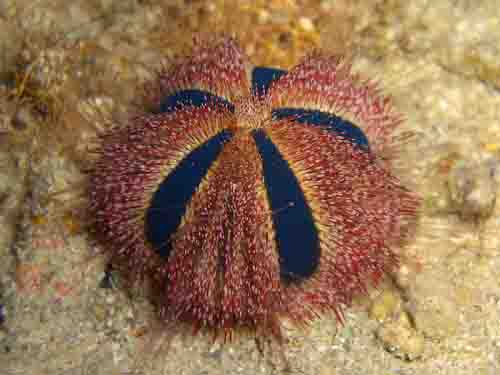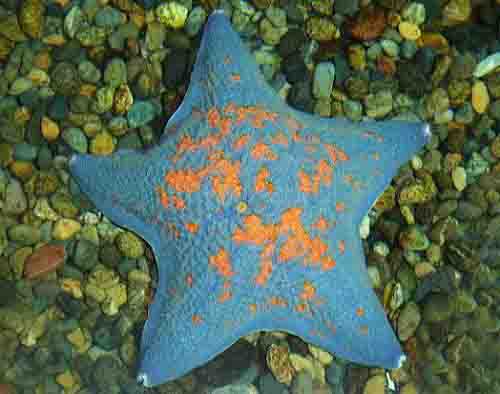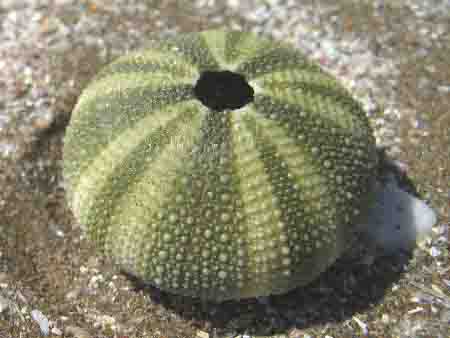Creature with a pentagonal body
Most living things on Earth have bilaterally symmetrical shapes. There are some exceptions, including echinoderms such as starfish and sea urchins. The starfish’s body extends radially in five directions from the center. With this body, starfish have survived the harsh struggle for survival underwater for a long time.
体が五角形の生物
地球の生物は左右対称の形が大半です。一部例外がありヒトデやウニなどの棘皮動物は違います。ヒトデの体は中心から5つの方向に放射状に伸びています。ヒトデはこの体で水中の厳しい生存競争を長い間生きてきました。

Are bilaterally symmetrical creatures advantageous?
Normally living things have clear front and back and left and right sides. At the tip of the body is a head containing sensory organs and a brain. In order to move quickly for the purposes of eating and escaping, the skeleton and muscles must be symmetrical. The body structure of living things is such that it can move quickly forward.
左右対称の生物は有利?
普通生物は前後と左右がはっきりしています。体の先端に感覚器と脳を収めた頭部があります。食べる、逃げるという目的のために、素早く移動するためには骨格と筋肉が左右対称でなければなりません。生物の体の構造は前方に素速く移動できる体の構造になっています。

Are radial creatures at a disadvantage?
On the other hand, echinoderms such as starfish and sea urchins are different. Echinoderms have five similar shapes radiating from the center. This is called pentaradial symmetry, and it is not a body shape that allows for quick action. But they found ways to survive without moving quickly, and to some extent they were successful. Underwater, the pentagonal shape was efficient for slow-moving creatures to catch food flowing from all directions. Since sea urchins eat seaweed such as kelp, it is not a problem even if they move slowly. Interestingly, sea urchins have a symmetrical body when they are young, but as they grow up, they change into a strong pentagonal skeleton.
放射状の生物は不利?
一方ヒトデやウニなどの棘皮動物は違います。棘皮動物は5つの似た形が中心から放射状にならびます。これを五放射相称と呼び、 素早く行動できる体形ではありません。しかし彼らは素早く移動しなくても生き延びる方法を見つけ、ある程度は成功しました。水中で五角形は動きが鈍い生き物にとって全方向から流れてくるエサを取るために効率が良かったのです。ウニは昆布などの海藻を食べているので動きは鈍くても問題になりません。興味深いことにウニは幼体の時は左右対称の体ですが 成長すると5角形の強い骨格に変化します。

Sea urchins have survived without dying out.
Radial (pentagonal) creatures have flourished from the Cambrian period of the Paleozoic era, about 500 million years ago, to the present day. The pentagonal shape of a sea urchin’s body is said to be convenient for survival in water. Creatures with radial (pentagonal) bodies were not at a disadvantage.
ウニは滅びることなく生存してきた。
放射状(5角形)の生物は古生代のカンブリア紀、約5億年前から現在まで繁栄しています。ウニの体が5角形なのは水中で生き残るのに都合が良かったといえます。放射状(5角形)の体の生物は不利ではありませんでした。
Even though their bodies were pentagonal, sea urchins and starfish were able to survive the mass extinctions that began in the Paleozoic era.
体が5角形でもウニやヒトデは古生代からの生物大量絶滅を生き残ることができました。 ウニがどんな形をしているかは人間にとってはどうでもいいことで、重要なのはウニを安く食べれかと言うことです。








